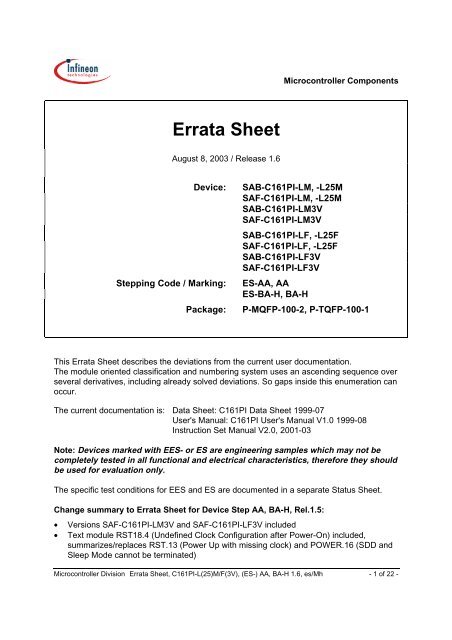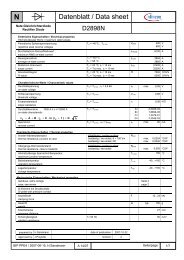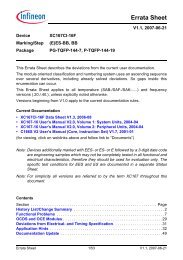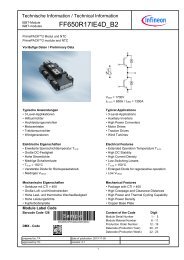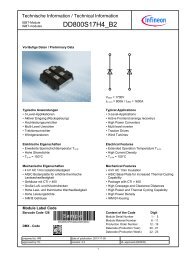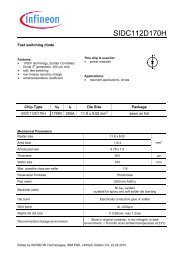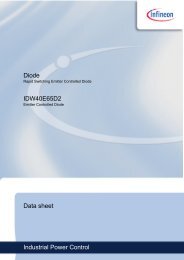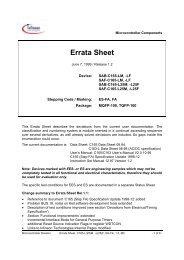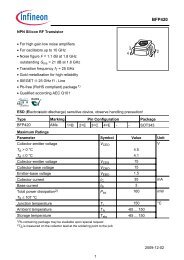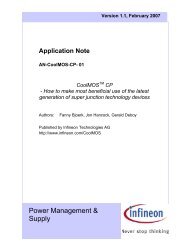C161PI AA / BA-H Step - Infineon
C161PI AA / BA-H Step - Infineon
C161PI AA / BA-H Step - Infineon
You also want an ePaper? Increase the reach of your titles
YUMPU automatically turns print PDFs into web optimized ePapers that Google loves.
Microcontroller Components<br />
Errata Sheet<br />
August 8, 2003 / Release 1.6<br />
Device:<br />
<strong>Step</strong>ping Code / Marking:<br />
Package:<br />
SAB-<strong>C161PI</strong>-LM, -L25M<br />
SAF-<strong>C161PI</strong>-LM, -L25M<br />
SAB-<strong>C161PI</strong>-LM3V<br />
SAF-<strong>C161PI</strong>-LM3V<br />
SAB-<strong>C161PI</strong>-LF, -L25F<br />
SAF-<strong>C161PI</strong>-LF, -L25F<br />
SAB-<strong>C161PI</strong>-LF3V<br />
SAF-<strong>C161PI</strong>-LF3V<br />
ES-<strong>AA</strong>, <strong>AA</strong><br />
ES-<strong>BA</strong>-H, <strong>BA</strong>-H<br />
P-MQFP-100-2, P-TQFP-100-1<br />
This Errata Sheet describes the deviations from the current user documentation.<br />
The module oriented classification and numbering system uses an ascending sequence over<br />
several derivatives, including already solved deviations. So gaps inside this enumeration can<br />
occur.<br />
The current documentation is: Data Sheet: <strong>C161PI</strong> Data Sheet 1999-07<br />
User's Manual: <strong>C161PI</strong> User's Manual V1.0 1999-08<br />
Instruction Set Manual V2.0, 2001-03<br />
Note: Devices marked with EES- or ES are engineering samples which may not be<br />
completely tested in all functional and electrical characteristics, therefore they should<br />
be used for evaluation only.<br />
The specific test conditions for EES and ES are documented in a separate Status Sheet.<br />
Change summary to Errata Sheet for Device <strong>Step</strong> <strong>AA</strong>, <strong>BA</strong>-H, Rel.1.5:<br />
• Versions SAF-<strong>C161PI</strong>-LM3V and SAF-<strong>C161PI</strong>-LF3V included<br />
• Text module RST18.4 (Undefined Clock Configuration after Power-On) included,<br />
summarizes/replaces RST.13 (Power Up with missing clock) and POWER.16 (SDD and<br />
Sleep Mode cannot be terminated)<br />
Microcontroller Division Errata Sheet, <strong>C161PI</strong>-L(25)M/F(3V), (ES-) <strong>AA</strong>, <strong>BA</strong>-H 1.6, es/Mh - 1 of 22 -
• Z Flag after PUSH and PCALL (CPU.22)<br />
• Sleep Mode with RTC on cannot be terminated (POWER.17)<br />
• Note on Early (Unlatched) Chip Select Option (Section Application Hints)<br />
• PLL lock after temporary clock failure (Section Application Hints)<br />
Functional Problems:<br />
ADC.11: Modifications of ADM field while bit ADST = 0<br />
The A/D converter may unintentionally start one auto scan single conversion sequence when the<br />
following sequence of conditions is true:<br />
(1) the A/D converter has finished a fixed channel single conversion of an analog channel n > 0 (i.e.<br />
contents of ADCON.ADCH = n during this conversion)<br />
(2) the A/D converter is idle (i.e. ADBSY = 0)<br />
(3) then the conversion mode in the ADC Mode Selection field ADM is changed to Auto Scan Single<br />
(ADM = 10b) or Continuous (ADM = 11b) mode without setting bit ADST = 1 with the same<br />
instruction<br />
Under these conditions, the A/D converter will unintentionally start one auto scan single conversion<br />
sequence, beginning with channel n-1, down to channel number 0.<br />
In case the channel number ADCH has been changed before or with the same instruction which<br />
selected the auto scan mode, this channel number has no effect on the unintended auto scan<br />
sequence (i.e. it is not used in this auto scan sequence).<br />
Note:<br />
When a conversion is already in progress, and then the configuration in register ADCON is changed,<br />
- the new conversion mode in ADM is evaluated after the current conversion<br />
- the new channel number in ADCH and new status of bit ADST are evaluated after the current<br />
conversion when a conversion in fixed channel conversion mode is in progress, and after the<br />
current conversion sequence (i.e. after conversion of channel 0) when a conversion in an auto<br />
scan mode is in progress.<br />
In this case, it is a specified operational behaviour that channels n-1 .. 0 are converted when ADM is<br />
changed to an auto scan mode while a fixed channel conversion of channel n is in progress (see e.g.<br />
C167 User's Manual, V2.0, p16-4)<br />
Workaround:<br />
When an auto scan conversion is to be performed, always start the A/D converter with the same<br />
instruction which sets the configuration in register ADCON.<br />
PRT.3: Special Thresholds for Port 2 pins and P3.0, P3.1<br />
When bit P2HIN = 1 in register PICON, the Port 2 pins will still recognize external input signals<br />
according to the standard (TTL) thresholds V IL<br />
and V IH<br />
without hysteresis.<br />
When bit P3LIN = 1 in register PICON, the Port 3 pins P3.0 and P3.1 will recognize external input<br />
signals according to the specific threshold V IL1<br />
and V IH<br />
for I 2 C bus operation.<br />
Microcontroller Division Errata Sheet, <strong>C161PI</strong>-L(25)M/F(3V), (ES-) <strong>AA</strong>, <strong>BA</strong>-H 1.6, es/Mh - 2 of 22 -
PWRDN.1:<br />
Execution of PWRDN Instruction while pin NMI# = high<br />
When instruction PWRDN is executed while pin NMI# is at a high level, power down mode should not<br />
be entered, and the PWRDN instruction should be ignored. However, under the conditions described<br />
below, the PWRDN instruction may not be ignored, and no further instructions are fetched from<br />
external memory, i.e. the CPU is in a quasi-idle state. This problem will only occur in the following<br />
situations:<br />
a) the instructions following the PWRDN instruction are located in external memory, and a multiplexed<br />
bus configuration with memory tristate waitstate (bit MTTCx = 0) is used, or<br />
b) the instruction preceding the PWRDN instruction writes to external memory or an XPeripheral<br />
(XRAM, CAN), and the instructions following the PWRDN instruction are located in external<br />
memory. In this case, the problem will occur for any bus configuration.<br />
Note: the on-chip peripherals are still working correctly, in particular the Watchdog Timer will reset the<br />
device upon an overflow. Interrupts and PEC transfers, however, can not be processed. In case NMI#<br />
is asserted low while the device is in this quasi-idle state, power down mode is entered.<br />
Workaround:<br />
Ensure that no instruction which writes to external memory or an XPeripheral precedes the PWRDN<br />
instruction, otherwise insert e.g. a NOP instruction in front of PWRDN. When a multiplexed bus with<br />
memory tristate waitstate is used, the PWRDN instruction should be executed out of internal RAM or<br />
XRAM.<br />
POWER.14: Wake Up from Sleep Mode not possible in PLL Mode<br />
Sleep mode can not be terminated by external interrupt (NMI or fast external interrupts including<br />
alternate sources – see register EXISEL).<br />
Workarounds:<br />
• Avoid sleep mode with PLL mode (use deep idle instead: all peripherals off and slow down<br />
divider/32 and idle mode)<br />
• Use HW reset instead of interrupt<br />
For devices with register RSTCON 1) only: Switch to direct drive mode before selecting sleep mode.<br />
( 1) RSTCON currently not implemented in <strong>C161PI</strong>)<br />
POWER.15: Sleep Mode not possible in Prescaler Mode<br />
In prescaler mode (f CPU<br />
= f OSC<br />
/2) instead of sleep the device enters an undefined state and no wake up<br />
is possible except HW reset.<br />
Workaround:<br />
• Avoid sleep mode with prescaler mode (use deep idle instead: all peripherals off and slow down<br />
divider/32 and idle mode)<br />
• For devices with register RSTCON 1) only: Switch to direct drive mode before selecting sleep mode<br />
(but take care on max. f CPU<br />
) ( 1) RSTCON currently not implemented in <strong>C161PI</strong>)<br />
Microcontroller Division Errata Sheet, <strong>C161PI</strong>-L(25)M/F(3V), (ES-) <strong>AA</strong>, <strong>BA</strong>-H 1.6, es/Mh - 3 of 22 -
POWER.16: SDD and Sleep Mode cannot be terminated<br />
After each power-on a problem with the internal clock lock detection can occur. Due to this the Slow<br />
Down Mode and the Sleep Mode (for derivatives with Sleep Mode implemented only) cannot be<br />
terminated (as they wait for the clock lock condition). It is not possible to switch back the clock path<br />
from Slow Down Mode to Direct Drive-, Prescaler- or PLL-Mode.<br />
Note: In this case the bit CLKLOCK in register SYSCON2 always remains cleared.<br />
Workaround:<br />
(1) Direct Drive or Prescaler Mode:<br />
Instead of switching back to Direct Drive or Prescaler Mode it is recommended to stay in Slow<br />
Down Mode and to set the Slow Down Factor to One (SYSCON2: CLKREL = 0000b).<br />
(2) PLL Mode:<br />
It is recommended to increase the external oscillator frequency via hardware, up to CPU frequency<br />
and to use Direct Drive Mode with workaround (1)<br />
POWER.17: Sleep Mode with RTC on cannot be terminated<br />
After the wake up signal from sleep mode is recognized, the device enables the clock system.<br />
However, the device does not wait for stable PLL clock but wakes up the CPU and peripherals before.<br />
Due to this the device remains in sleep mode.<br />
Workarounds:<br />
• Select direct drive mode.<br />
• Select sleep mode with RTC off.<br />
X9: Read Access to XPERs in Visible Mode<br />
The data of a read access to an XBUS-Peripheral (XRAM, I 2 C) in Visible Mode is not driven to the<br />
external bus. PORT0 is tristated during such read accesses.<br />
Note that in Visible Mode PORT1 will drive the address for an access to an XBUS-Peripheral, even<br />
when only a multiplexed external bus is enabled.<br />
CPU.21<br />
BFLDL/BFLDH Instructions after Write Operation to internal IRAM<br />
The result of a BFLDL/BFLDH (=BFLDx) instruction may be incorrect if the following conditions are true<br />
at the same time:<br />
(1) the previous 'instruction' is a PEC transfer which writes to IRAM, or any instruction with result write<br />
back to IRAM (addresses 0F200h..0FDFFh for 3 Kbyte module, 0F600h..0FDFFh for 2 Kbyte<br />
module, or 0FA00h..0FDFFh for 1 Kbyte module). For further restrictions on the destination<br />
address see case (a) or case (b) below.<br />
(2) the BFLDx instruction immediately follows the previous instruction or PEC transfer within the<br />
instruction pipeline ('back-to-back' execution), i.e. decode phase of BFLDx and execute phase of<br />
the previous instruction or PEC transfer coincide. This situation typically occurs during program<br />
execution from internal program memory (ROM/OTP/Flash), or when the instruction queue is full<br />
during program execution from external memory<br />
Microcontroller Division Errata Sheet, <strong>C161PI</strong>-L(25)M/F(3V), (ES-) <strong>AA</strong>, <strong>BA</strong>-H 1.6, es/Mh - 4 of 22 -
(3) the 3 rd byte of BFLDx (= #mask8 field of BFLDL or #data8 field of BFLDH) and the destination<br />
address of the previous instruction or PEC transfer match in the following way:<br />
(a) value of #mask8 of BFLDL or #data8 of BFLDH = 0Fyh (y = 0..Fh),<br />
and the previous instruction or PEC writes to (the low and/or high byte of) GPR Ry or the<br />
memory address of Ry (determined by the context pointer CP) via any addressing mode.<br />
(b) value of #mask8 of BFLDL or #data8 of BFLDH = 00h..0EFh,<br />
and the lower byte v L<br />
of the contents v of the IRAM location or (E)SFR or GPR which is read<br />
by BFLDx is 00h ≤ v L<br />
≤ 7Fh<br />
and the previous instruction or PEC transfer writes to the (low and/or high byte of) the specific<br />
bit-addressable IRAM location 0FD00h + 2 v L<br />
(i.e. the 8-bit offset address of the location in the<br />
bit-addressable IRAM area (0FD00h..0FDFFh) equals v L<br />
).<br />
When the problem occurs, the actual result (all 16 bits) of the BFLDx instruction is bitwise ORed with<br />
the (byte or word) result of the previous instruction or PEC transfer.<br />
Notes:<br />
Write operations in the sense of the problem description include implicit write accesses caused by<br />
- auto-increment operations of the PEC source or destination pointers (which are located on<br />
0FCE0h..0FCFEh in IRAM)<br />
- post-increment/pre-decrement operations on GPRs (addressing modes with [R+] or [-R])<br />
- write operations on the system stack (which is located in IRAM).<br />
In case PEC write operations to IRAM locations which match the above criteria (bit-addressable or<br />
active register bank area, PEC pointers not overlapping with register bank area) can be excluded, the<br />
problem will not occur when the instruction preceding BFLDx in the dynamic flow of the program is one<br />
of the following instructions (which do not write to IRAM):<br />
NOP<br />
ATOMIC, EXTx<br />
CALLA/CALLI/JBC/JNBS when branch condition = false<br />
JMPx, JB, JNB<br />
RETx (except RETP)<br />
CMP(B) (except addressing mode with [Rwi+]), BCMP<br />
MULx, DIVx<br />
IDLE, PWRDN, DISWDT, SRVWDT, EINIT, SRST<br />
For implicit IRAM write operations caused by auto-increment operations of the PEC source or<br />
destination pointers, the problem can only occur if the value of #mask8 of BFLDL or #data8 of<br />
BFLDH = 0Fyh (y = 0..Fh), and the range which is covered by the context pointer CP (partially or<br />
completely) overlaps the PEC source and destination pointer area (0FCE0h..0FCFEh), and the<br />
address of the source or destination pointer which is auto-incremented after the PEC transfer is equal<br />
to the address of GPR Ry (included in case 3a).<br />
For system stack write operations, the problem can only occur if the system stack is located in the<br />
bit-addressable portion of IRAM (0FD00h..0FDFFh), or if the system stack can overlap the register<br />
bank area (i.e. the register bank area is located below the system stack, and the distance between the<br />
contents of the context pointer CP and the stack pointer SP is ≤ 20h).<br />
Workaround 1:<br />
When a critical instruction combination or PEC transfer to IRAM can occur, then substitute the BFLDx<br />
instruction by<br />
(a) an equivalent sequence of single bit instructions. This sequence may be included in an<br />
uninteruptable ATOMIC or EXTEND sequence to ensure completion after a defined time.<br />
Microcontroller Division Errata Sheet, <strong>C161PI</strong>-L(25)M/F(3V), (ES-) <strong>AA</strong>, <strong>BA</strong>-H 1.6, es/Mh - 5 of 22 -
(b) an equivalent byte- or word MOV or logical instruction.<br />
Note that byte operations to SFRs always clear the non-addressed complementary byte.<br />
Note that protected bits in SFRs are overwritten by MOV or logical instructions.<br />
Workaround 2:<br />
When a critical instruction combination occurs, and PEC write operations to IRAM locations which<br />
match the above criteria (bit-addressable or active register bank area) can be excluded, then<br />
rearrange the BFLDx instruction within the instruction environment such that a non-critical instruction<br />
sequence is generated.<br />
Workaround 3:<br />
When a critical instruction combination or PEC transfer to IRAM can occur, then<br />
- replace the BFLDx instruction by the instruction sequence<br />
ATOMIC #1<br />
BFLDx<br />
This means e.g. when BFLDx was a branch target before, ATOMIC # 1 is now the new branch<br />
target.<br />
In case the BFLDx instruction is included at position n in an ATOMIC or EXTEND sequence with range<br />
operator #m (n, m = 2..4, n ≤ m), then<br />
- insert (repeat) the corresponding ATOMIC or EXTEND instruction at position n with range operator<br />
#z where z = (m - n) + 1<br />
Position of BFLDx<br />
within ATOMIC/<br />
EXT.. sequence<br />
Range of original ATOMIC/EXTEND statement<br />
1 2 3 4<br />
1 no problem / no<br />
workaround<br />
no problem / no<br />
workaround<br />
no problem / no<br />
workaround<br />
no problem / no<br />
workaround<br />
2 - - z = 1 z = 2 z = 3<br />
3 - - - - z = 1 z = 2<br />
4 - - - - - - z = 1<br />
- - : case can not occur<br />
Note on devices with power management and register RSTCON:<br />
for unlock sequences, which are sequences of four instructions operating on ESFRs SYSCON1/2/3<br />
and RSTCON and which are included in an EXTR #4 sequence, this workaround must not be<br />
implemented when the 4 th instruction is a BFLDx instruction, otherwise the unlock sequence will<br />
not work correctly (in fact unlock sequences don't require a workaround).<br />
Tool Support<br />
The Keil C166 Compiler V3.xx generates BFLD instructions only in the following cases:<br />
- when using the _bfld_ intrinsic function.<br />
- at the beginning of interrupt service routines, when using #pragma disable<br />
- at the end of interrupt service routines, when using the chip bypass directive FIX166.<br />
The C166 Compiler V4.xx uses the BFLD instruction to optimize bit-field struct accesses. Release<br />
C166 V4.10 offers a new directive called FIXBFLD that inserts an ATOMIC #1 instruction before every<br />
BFLD instruction that is not enclosed in an EXTR sequence. Detailed information can be found in the<br />
C166\HLP\RELEASE.TXT of C166 Version 4.10.<br />
Microcontroller Division Errata Sheet, <strong>C161PI</strong>-L(25)M/F(3V), (ES-) <strong>AA</strong>, <strong>BA</strong>-H 1.6, es/Mh - 6 of 22 -
The C166 Run-Time Library for C166 V3.xx and V4.xx uses BFLD instructions only in the<br />
START167.A66 file. This part of the code should be not affected by the CPU.21 problem but should be<br />
checked by the software designer.<br />
The RTX166 Full Real-Time Operating system (any version) does not use BFLD instructions.<br />
For RTX166 Tiny, you should rebuild the RTX166 Tiny library with the SET FIXBFLD = 1 directive. This<br />
directive is enabled in the assembler source file RTX166T.A66. After change of this setting rebuild the<br />
RTX166 Tiny library that you are using in your application.<br />
The Tasking support organization provides a v7.0r1 A166 Assembler (build 177) including a check for<br />
problem CPU.21 with optional pec/no_pec feature. This assembler version can also be used to check<br />
code which was generated with previous versions of the Tasking tool chain. A v7.0r1 C166 Compiler<br />
(build 368) offering a workaround for problem CPU.21 is also available from Tasking.<br />
The scan tool aiScan21 analyzes files in hex format plus user-supplied additional information (locator<br />
map file, configuration file), checks whether they may be affected by problem CPU.21, and produces<br />
diagnostic information about potentially critical instruction sequences. This tool is included in AP1628<br />
'Scanning for Problem CPU.21' on<br />
http://www.infineon.com/cgi/ecrm.dll/ecrm/scripts/prod_cat.jsp?oid=-8137<br />
CPU.22:<br />
Z Flag after PUSH and PCALL<br />
The Z flag in the PSW is erroneously set to '1' by PUSH reg or PCALL reg, rel instructions when all of<br />
the following conditions are true:<br />
(a) for PUSH reg instructions:<br />
- the contents of the high byte of the GPR or (E)SFR which is pushed is 00h, and<br />
- the contents of the low byte of the GPR or (E)SFR which is pushed is > 00h, and<br />
- the contents of GPR Rx is odd, where x = 4 msbs of the 8-bit 'reg' address of the pushed GPR<br />
or (E)SFR<br />
Examples:<br />
PUSH R1 (coding: F1 EC): incorrect setting of Z flag if contents of R15 is odd,<br />
and 00FFh ≥ contents of R1 ≥ 0001h<br />
PUSH DPP3 (coding: 03 EC): incorrect setting of Z flag if contents of R0 is odd,<br />
and 00FFh ≥ contents of DPP3 ≥ 0001h<br />
(b) for PCALL reg, rel instructions:<br />
- when the contents of the high byte of the GPR or (E)SFR which is pushed is 00h, and<br />
- when the contents of the low byte of the GPR or (E)SFR which is pushed is odd<br />
This may lead to wrong results of instructions following PUSH or PCALL if those instructions explicitly<br />
(e.g. BMOV .. , Z; JB Z, ..; ..) or implicitly (e.g. JMP cc_Z, ..; JMP cc_NET, ..; ..) evaluate the status of<br />
the Z flag before it is newly updated.<br />
Note that some instructions (e.g. CALL, ..) have no effect on the status flags, such that the status of the<br />
Z flag remains incorrect after a PUSH/PCALL instruction until an instruction that correctly updates the<br />
Z flag is executed.<br />
Microcontroller Division Errata Sheet, <strong>C161PI</strong>-L(25)M/F(3V), (ES-) <strong>AA</strong>, <strong>BA</strong>-H 1.6, es/Mh - 7 of 22 -
Example:<br />
PUSH R1 ; incorrect setting of Z flag if R15 is odd<br />
CALL proc_xyz ; Z flag remains unchanged (is a parameter for proc_xyz)<br />
...<br />
proc_xyz:<br />
JMP cc_Z,end_xyz ; Z flag evaluated with incorrect setting<br />
...<br />
end_xyz:<br />
Effect on Tools:<br />
The Hightec C166 tools (all versions) don't use the combination of PUSH/PCALL and the evaluation of<br />
the Z flag. Therefore, these tools are not affected.<br />
The code generated by the Keil C166 Compiler evaluates the Z flag only after MOV, CMP, arithmetic,<br />
or logical instructions. It is never evaluated after a PUSH instruction. PCALL instructions are not<br />
generated by the C166 Compiler.<br />
This has been checked with all C166 V3.xx and V4.xx compiler versions. Even the upcoming V5.xx is<br />
not affected by the CPU.22 problem.<br />
The assembler portions of the C166 V3.xx and V4.xx Run-Time Libraries, the RTX166 Full and TX166<br />
Tiny Real Time Operating system do also not contain any evaluation of the Z flag after PUSH or<br />
PCALL.<br />
The TASKING compiler V7.5r2 never generates a PCALL instruction, nor is it used in the libraries. The<br />
PUSH instruction is only used in the entry of an interrupt frame, and sometimes on exit of normal<br />
functions. The zero flag is not a parameter or return value, so this does not give any problems.<br />
Previous versions of TASKING tools: V3.x and higher are not affected, versions before 3.x are most<br />
likely not affected. Contact TASKING when using versions before V3.x.<br />
Since code generated by the C166 compiler versions mentioned before is not affected, analysis and<br />
workarounds are only required for program parts written in assembler, or instruction sequences<br />
inserted via inline assembly.<br />
Workaround (for program parts written in assembler):<br />
Do not evaluate the status of the Z flag generated by a PUSH or PCALL instruction. Instead, insert an<br />
instruction that correctly updates the PSW flags, e.g.<br />
PUSH reg<br />
CMP reg, #0<br />
; updates PSW flags<br />
; note: CMP additionally modifies the C and V flags,<br />
; while PUSH or MOV leaves them unaffected<br />
JMPR cc_Z, label_1 ; implicitly tests Z flag<br />
or<br />
PCALL reg, procedure_1<br />
...<br />
procedure_1:<br />
MOV ONES, reg ; updates PSW flags<br />
JMPR cc_NET, label_1 ; implicitly tests flags Z and E<br />
Microcontroller Division Errata Sheet, <strong>C161PI</strong>-L(25)M/F(3V), (ES-) <strong>AA</strong>, <strong>BA</strong>-H 1.6, es/Mh - 8 of 22 -
Hints for Detection of Critical Instruction Combinations<br />
Whether or not an instruction following PUSH reg or PCALL reg, rel actually causes a problem<br />
depends on the program context. In most cases, it will be sufficient to just analyze the instruction<br />
following PUSH or PCALL. In case of PCALL, this is the instruction at the call target address.<br />
- Support Tool for Analysis of Hex Files<br />
For complex software projects, where a large number of assembler source (or list) files would have to<br />
be analyzed, <strong>Infineon</strong> provides a tool aiScan22 which scans hex files for critical instruction sequences<br />
and outputs diagnostic information. This tool is available as part of the Application Note ap1679<br />
'Scanning for Problem CPU.22' on the 16-bit microcontroller internet pages of <strong>Infineon</strong> Technologies:<br />
http://www.infineon.com/cgi/ecrm.dll/ecrm/scripts/prod_cat.jsp?oid=-8137<br />
direct links:<br />
http://www.infineon.com/cmc_upload/documents/040/841/ap1679_v1.1_2002_05_scanning_cpu22.pdf<br />
http://www.infineon.com/cgi/ecrm.dll/ecrm/scripts/public_download.jsp?oid=40840&parent_oid=-8137<br />
- Individual Analysis of Assembler Source Code<br />
With respect to problem CPU.22, all instructions of the C166 instruction set can be classified into the<br />
following groups:<br />
• Arithmetic/logic/data movement instructions as successors of PUSH/PCALL (correctly) modify<br />
the condition flags in the PSW according to the result of the operation.<br />
- These instructions may only cause a problem if the PSW is a source or source/destination<br />
operand:<br />
ADD/B, ADDC/B, CMP/B, CMPD1/2, CMPI1/2, SUB/B, SUBC/B<br />
AND/B, OR/B, XOR/B<br />
ASHR<br />
MOV/B, MOVBZ/MOVBS<br />
SCXT<br />
PUSH, PCALL ; analysis must be repeated for successor of PUSH/PCALL<br />
• The following instructions (most of them with immediate or register (Rx) addressing modes) can<br />
never cause a problem when they are successors of PUSH/PCALL:<br />
CPL/B, NEG/B<br />
DIV/U, DIVL/U, MUL/U<br />
SHL/SHR, ROL/ROR, PRIOR<br />
POP<br />
RETI ; updates complete PSW with stacked value<br />
RETP ; updates condition flags<br />
PWRDN ; program restarts after reset<br />
SRST ; program restarts<br />
• Conditional branch instructions which may evaluate the Z flag as successors of PUSH/PCALL:<br />
JB/JNB Z, rel ; directly evaluates Z flag<br />
CALLA/CALLI, JMPA/JMPI/JMPR with the following condition codes<br />
cc_Z, cc_EQ, cc_NZ, cc_NE<br />
cc_ULE, cc_UGT, cc_SLE, cc_SGT<br />
cc_NET<br />
Microcontroller Division Errata Sheet, <strong>C161PI</strong>-L(25)M/F(3V), (ES-) <strong>AA</strong>, <strong>BA</strong>-H 1.6, es/Mh - 9 of 22 -
- For these branch conditions, the branch may be performed in the wrong way.<br />
- For other branch conditions, the branch target as well as the linear successor of the branch<br />
instruction must be analyzed (since these branch instruction don't modify the PSW flags).<br />
• For instructions that have no effect on the condition flags and that don't evaluate the Z flag,<br />
the instruction that follows this instruction must be analyzed. These instructions are<br />
NOP<br />
ATOMIC, EXTxx<br />
DISWDT, EINIT, IDLE, SRVWDT<br />
CALLR, CALLS, JMPS<br />
RET, RETS<br />
TRAP<br />
; branch target must be analyzed<br />
; return target must be analyzed (value pushed by PUSH/PCALL = return IP,<br />
; Z flag contains information whether intra-segment target address = 0000h or not)<br />
; both trap target and linear successor must be analyzed, since Z flag may be<br />
; incorrect in PSW on stack as well as in PSW at entry of trap routine<br />
• For bit modification instructions, the problem may only occur if a source bit is the Z flag, and/or<br />
the destination bit is in the PSW, but not the Z flag. These instructions are:<br />
BMOV/BMOVN<br />
<strong>BA</strong>ND/BOR/BXOR<br />
BCMP<br />
BFLDH<br />
BFLDL<br />
BCLR/BSET<br />
JBC/JNBS<br />
; problem only if bit 3 of @@ mask = 0, i.e. if Z is not selected<br />
; problem only if operand is not Z flag<br />
; wrong branch if operand is Z flag<br />
RST.18.4<br />
Undefined Clock Configuration after Power-On<br />
Problem Description<br />
During power-on or during a power off/on sequence it is possible that the internal clock configuration of<br />
the power management is not set to a defined state. An undefined state of the power management<br />
clock configuration can cause different kinds of malfunctions in the system. The below described<br />
malfunction does not always occur but can appear sporadically.<br />
Conditions to get a defined Clock Configuration at Power-On<br />
During power-on or during a power off/on sequence all of the following three conditions must be fulfilled<br />
that the internal oscillator lock signal can be set and the real time clock registers will be cleared<br />
(power-on detection OK)<br />
• Power off/on recovery time must be 4 seconds or longer.<br />
• The input voltage V IN<br />
at all pins has to be V IN<br />
≤ 0.3 V for the duration of the power off/on recovery<br />
time.<br />
• During power-on (rise time of V DD<br />
) RSTIN# has to be active and is required at least until the clock<br />
at XTAL1 is stable. The input level of RSTIN# has to be<br />
V RSTIN#<br />
≤ 0.3 * V DD<br />
for 0 V ≤ V DD<br />
< 2.7 V and<br />
V RSTIN#<br />
≤ 0.8 V for 2.7 V ≤ V DD<br />
≤ 4.5 V.<br />
Defined state of the Power Management Clock Configuration after Power-On<br />
After a power-on which fulfills the three mentioned conditions the internal oscillator lock signal is set<br />
after oscillator start-up and the real time clock registers are cleared (T14, T14REL, RTCH RTCL).<br />
Microcontroller Division Errata Sheet, <strong>C161PI</strong>-L(25)M/F(3V), (ES-) <strong>AA</strong>, <strong>BA</strong>-H 1.6, es/Mh - 10 of 22 -
Root cause of the Problem:<br />
If the conditions to get a defined clock configuration at power-on are not fulfilled then it is possible that<br />
the internal power-on detection unit does not detect power-on. Whether power-on was detected or not<br />
can be checked with WDTCON.5. If power-on was detected then WDTCON.5 = 1 else WDTCON.5 =<br />
0. The function of bit WDTCON.5 is implemented for evaluation purposes and is not guaranteed.<br />
If power-on was not detected by the on-chip power-on detection unit then this can cause a malfunction<br />
of the internal oscillator lock detect unit. In that case the internal oscillator lock signal is not set after<br />
2048 XTAL1 clock periods.<br />
Effects on the system in case of an undefined Power Management Clock<br />
Configuration and possible Workarounds<br />
Because of the high flexibility of the clock configuration during and after power-on, different cases of<br />
clock sources and clock paths have to be considered.<br />
Case 1: This is only included because of Compatibility of Numbering<br />
Case 2: This is only included because of Compatibility of Numbering<br />
Case 3: Clock @ XTAL1 and Power-on Detection FAIL<br />
When the power-on detection fails during power-on because of not considering the necessary<br />
conditions, the register bit CLKLOCK and the RTC registers are undefined. Further the oscillator lock<br />
signal is not set.<br />
When the system is running in direct drive or PLL clock mode, it is possible to switch the clock path to<br />
SDD mode via software. But it is NOT possible to switch back to the clock path of direct drive or PLL<br />
clock mode (basic clock) because the switch back mechanism will wait for the oscillator lock signal.<br />
Workarounds:<br />
• Consider the conditions to get a defined clock configuration at power-on<br />
• In systems where direct drive or prescaler mode is used it is possible to set the SDD to factor one<br />
or two and to stay in SDD mode (no oscillator watchdog function possible).<br />
Case 4: NO Clock @ XTAL1 and Power-on Detection FAIL<br />
If the system gets no clock at XTAL1 during power-on and the power-on detection fails then the<br />
following settings can be found:<br />
• The real time clock registers are undefined (T14, T14REL, RTCH, RTCL).<br />
• The slow down divider (SDD) may be selected as f CPU<br />
clock source (no oscillator watchdog function<br />
possible). In that case the system will stop.<br />
Workaround:<br />
Consider the conditions to get a defined clock configuration at power-on.<br />
Microcontroller Division Errata Sheet, <strong>C161PI</strong>-L(25)M/F(3V), (ES-) <strong>AA</strong>, <strong>BA</strong>-H 1.6, es/Mh - 11 of 22 -
C16x Family Clock Configuration<br />
WDTCON<br />
-<br />
LHW<br />
R<br />
SHW<br />
R<br />
SW<br />
R<br />
WDT<br />
R<br />
WDT<br />
IN<br />
CLK<br />
Lock<br />
SYSCON2<br />
CLK<br />
CLKCON<br />
HIX<br />
RCS RCS<br />
XTAL1<br />
Power-on<br />
Detection<br />
Main<br />
Osc.<br />
P-on<br />
detect<br />
f OSC<br />
OSC<br />
Lock<br />
2048:1<br />
Oscillator Lock<br />
PLL Lock<br />
&<br />
Lock<br />
PLL<br />
Phase<br />
Locked<br />
Loop<br />
&<br />
Direct<br />
Drive<br />
sync<br />
Prescaler<br />
f CPU<br />
XTAL2<br />
XTAL3<br />
XTAL4<br />
Aux.<br />
Osc.<br />
f AUX<br />
0<br />
1<br />
Slow Down<br />
Divider<br />
SDD<br />
(n+1):1<br />
sync<br />
SCS<br />
2:1<br />
sync<br />
RCS<br />
P-on detect<br />
32:1<br />
0<br />
1<br />
f RTC<br />
T14REL<br />
8:1 T14<br />
RTCH<br />
RTC<br />
RTCL<br />
Basic_Clock_flow_C16x.vsd, V1.0, MP<br />
Note: The <strong>C161PI</strong> includes no auxiliary oscillator. Bits SCS and RCS are set to zero.<br />
RST.13:<br />
Power Up with missing Clock<br />
While no clock is provided at XTAL1 and<br />
- RSTIN = High (while V DD<br />
≤ 2V) or<br />
- power off/on recovery time is below 1 second (beginning from ≤ 0.3V at all pins)<br />
then the following settings can be found:<br />
• The realtime clock registers are not cleared (T14, T14REL, RTCH, RTCL).<br />
• The slow down divider (SDD) can be selected as f CPU<br />
clock source (no oscillator watchdog function<br />
possible – the device will stop while external clock is missing)<br />
Workaround: see RST18.4, case 4<br />
Microcontroller Division Errata Sheet, <strong>C161PI</strong>-L(25)M/F(3V), (ES-) <strong>AA</strong>, <strong>BA</strong>-H 1.6, es/Mh - 12 of 22 -
RST.9.3:<br />
Software/Watchdog/Short HW Reset during Slow Down operation with<br />
PLL off<br />
When a watchdog timer or software reset or short hardware reset occurs during slow down mode<br />
where the PLL has been switched off (CLKCON = 10 in register SYSCON2), the internal reset<br />
condition is extended until the next long HW reset.<br />
After the reset, if the PLL has not locked, flag PLLIR in register ISNC may not be set correctly, but<br />
the device continues operation on the PLL base frequency (2 .. 5 MHz).<br />
This problem only occurs when the PLL is used to generate the internal clock during normal operation,<br />
and it will not occur in direct drive or prescaler mode.<br />
Workarounds:<br />
Enable bi-directional reset mode (bit BDRSTEN = 1 in register SYSCON). The external reset circuit<br />
should prolong this reset until the PLL is locked again (approx. 1 ms).<br />
RST.8:<br />
Clock failure detection during external Reset<br />
A missing clock at pin XTAL1 during an external reset cannot be recognized via bit PLLIR (PLL/OWD<br />
interrupt request flag) in register ISNC (Interrupt Subnode Control) because bit PLLIR is cleared during<br />
reset. When the clock at pin XTAL 1 is missing the internal CPU clock is the PLL base frequency (2...5<br />
MHz).<br />
Workaround:<br />
(1) Clock options at PORT0 (P0H.7 ... 5) are set to Direct Drive or Prescaler mode:<br />
Use the Real Time Clock with main oscillator (default after Power-on reset) as input clock source.<br />
Check bit RTCIR (T14IR) of the Real Time Clock instead of bit PLLIR. If the RTC interrupt request<br />
does not occur in the expected time frame then the main oscillator does not oscillate.<br />
Instead of an interrupt controlled verification of the RTC activity also polling of register T14 for at<br />
least 256 XTAL1 cycles can be used to check whether the main oscillator is running.<br />
(2) Clock options at PORT0 (P0H.7 ... 5) are set to PLL mode:<br />
Bit CLKLOCK in SYSCON2 can be tested instead of bit PLLIR. CLKLOCK = 0 while the PLL is<br />
unlocked. The workaround described in case (1) can also be used instead of the CLKLOCK bit.<br />
Note:<br />
not all problems listed in the Errata Sheet may actually occur for every individual device of the<br />
<strong>C161PI</strong>. However, it is recommended to follow the workarounds given in the Errata Sheet to<br />
ensure stable production.<br />
Microcontroller Division Errata Sheet, <strong>C161PI</strong>-L(25)M/F(3V), (ES-) <strong>AA</strong>, <strong>BA</strong>-H 1.6, es/Mh - 13 of 22 -
Deviations from Electrical- and Timing Specification:<br />
The following table lists the deviations of the DC/AC characteristics from the specification in the<br />
<strong>C161PI</strong> Data Sheet 1999-07:<br />
Problem Parameter Symbol Limit Values Unit Test<br />
short name min. max. Condition<br />
AC.t34.n2<br />
CLKOUT rising edge to<br />
ALE falling edge<br />
t 34<br />
-2 + t A<br />
instead of<br />
- ns Standard Supply<br />
Voltage<br />
AC.t34.n10<br />
CLKOUT rising edge to<br />
ALE falling edge<br />
t 34<br />
0 + t A<br />
-10 + t A<br />
instead of<br />
0 + t A<br />
8 + t A<br />
ns Reduced Supply<br />
Voltage<br />
AC.t33.10 CLKOUT fall time t 33<br />
- 10<br />
instead of<br />
4 (8)<br />
DC.VDDRM.1 Reduced digital supply<br />
voltage<br />
V DD<br />
3.15<br />
instead of<br />
3.0<br />
ns<br />
Standard<br />
(Reduced)<br />
Supply Voltage<br />
3.6 V Devices with<br />
date code ≥<br />
0141<br />
Notes:<br />
1) During reset and adapt mode, the internal pull-ups on P6.[4:0] are active, independent whether<br />
the respective pins are used for CS# function after reset or not.<br />
Microcontroller Division Errata Sheet, <strong>C161PI</strong>-L(25)M/F(3V), (ES-) <strong>AA</strong>, <strong>BA</strong>-H 1.6, es/Mh - 14 of 22 -
Application Hints<br />
Maintenance of ISNC Register<br />
The RTC and PLL interrupts share one interrupt node (XP3IC). If an interrupt request occurs, the<br />
request bit in the Interrupt Subnode Control register has to be checked and cleared by software. To<br />
avoid a collision with the next hardware interrupt request of the same source, it is recommended to first<br />
clear the request and the enable bit, and then to set the enable bit again.<br />
• Example for a XP3 interrupt service routine (for Tasking C compiler):<br />
...<br />
if (PLLIR)<br />
{<br />
_bfld (ISNC, 0x000C, 0x0000); // clear PLLIE and PLLIR<br />
_putbit (1, ISNC, 3);<br />
// set PLLIE<br />
... // further actions concerning PLL/OWD<br />
}<br />
if (RTCIR)<br />
{<br />
_bfld (ISNC, 0x0003, 0x0000); // clear RTCIE and RTCIR<br />
_putbit (1, ISNC, 1);<br />
// set RTCIE<br />
... // further actions concerning RTC<br />
}<br />
...<br />
• In assembly language:<br />
...<br />
EXTR #1<br />
JNB PLLIR, no_pll_request<br />
EXTR #2 ; no further interruption of this sequence possible<br />
BFLDL ISNC, #0Ch, #00h ; clear PLLIE and PLLIR<br />
BSET PLLIE ; set PLLIE<br />
... ; further actions concerning PLL/OWD<br />
no_pll_request:<br />
EXTR #1<br />
JNB RTCIR, no_rtc_request<br />
EXTR #2 ; no further interruption of this sequence possible<br />
BFLDL ISNC, #03h, #00h ; clear RTCIE and RTCIR<br />
BSET RTCIE ; set RTCIE<br />
... ; further actions concerning RTC<br />
no_rtc_request:<br />
...<br />
Maximum (Main: Type_LP2) Oscillator Frequency = 16 MHz<br />
The main oscillator is optimized for oscillation with a crystal within a frequency range of 4...16 MHz.<br />
When driven by an external clock signal it will accept the specified frequency range. Operation at lower<br />
input frequencies is possible but is guaranteed by design only (not 100% tested).<br />
Main Oscillator Type_LP2: Negative Resistance and Start-up Reliability<br />
Compared to other C16x microcontrollers the gain of the on-chip oscillator (Type_LP2) is slightly<br />
different. It is recommended to check the negative resistance and the start-up reliability of the oscillator<br />
circuit in the original application. Please refer to the limits specified by the quartz crystal or ceramic<br />
resonator supplier.<br />
See also Application Note AP2420 'Crystal Oscillator of the C500 and C166 Microcontroller Families'<br />
and Application Note AP2424 'Ceramic Resonator Oscillators of the C500 and C166 Microcontroller<br />
Families' on http://www.infineon.com/cgi/ecrm.dll/ecrm/scripts/prod_cat.jsp?oid=-8137<br />
Microcontroller Division Errata Sheet, <strong>C161PI</strong>-L(25)M/F(3V), (ES-) <strong>AA</strong>, <strong>BA</strong>-H 1.6, es/Mh - 15 of 22 -
Oscillator Watchdog and Prescaler Mode<br />
The OWD replaces the missing oscillator clock signal with the PLL clock (base frequency).<br />
In direct drive mode the PLL base frequency is used directly (f CPU<br />
= 2...5 MHz).<br />
In prescaler mode the PLL base frequency is divided by 2 (f CPU<br />
= 1...2.5 MHz).<br />
PLL lock after temporary clock failure<br />
When the PLL is locked and the input clock at XTAL1 is interrupted then the PLL becomes unlocked,<br />
provides the base frequency (2 ... 5 MHz) and the PLL unlock interrupt request flag is set. If the<br />
XTAL1 input clock starts oscillation again then the PLL stays in the PLL base frequency. The CPU<br />
clock source is only switched back to the XTAL1 oscillator clock after a hardware reset. This can be<br />
achieved via a normal hardware reset or via a software reset with enabled bidirectional reset. It is<br />
important that the hardware reset is at least active for 1 ms, after that time the PLL is locked in any<br />
case.<br />
Handling of the SSC Busy Flag (SSCBSY)<br />
In master mode of the High-Speed Synchronous Serial Interface (SSC), when register SSCTB has<br />
been written, flag SSCBSY is set to '1' when the baud rate generator generates the next internal clock<br />
pulse. The maximum delay between the time SSCTB has been written and flag SSCBSY=1 is up to 1/2<br />
bit time. SSCBSY is cleared 1/2 bit time after the last latching edge.<br />
When polling flag SSCBSY after SSCTB has been written, SSCBSY may not yet be set to '1' when it is<br />
tested for the first time (in particular at lower baud rates). Therefore, e.g. the following alternative<br />
methods are recommended:<br />
1. test flag SSCRIR (receive interrupt request) instead of SSCBSY (in case the receive interrupt<br />
request is not serviced by CPU interrupt or PEC), e.g.<br />
loop: BCLR SSCRIR ;clear receive interrupt request flag<br />
MOV SSCTB, #xyz<br />
;send character<br />
wait_tx_complete:<br />
JNB SSCRIR, wait_tx_complete ;test SSCRIR<br />
JB SSCBSY, wait_tx_complete<br />
;test SSCBSY to achieve original<br />
timing(SSCRIR may be set 1/2 bit time before<br />
SSCBSY is cleared)<br />
2. use a software semaphore bit which is set when SSCTB is written and is cleared in the SSC<br />
receive interrupt routine<br />
Maximum I 2 C Bus Data Rate at low f CPU<br />
The I 2 C Bus module was designed for a high data rate (400 Kbit/s @ f CPU<br />
= 20 MHz). All module internal<br />
clocks are derived from f CPU<br />
. When a lower CPU frequency is used system limitations have to be<br />
considered like maximum data rate and clock symmetry. These effects may occur in particular for<br />
values of the baud rate prescaler BRP ≤ 5. More details are under evaluation.<br />
Overload Protection Circuit for I 2 C Bus Pins P3.0/P3.1, P6.5 ..P6.7<br />
Since these pins are used for alternate functions by the I 2 C Bus module, they have a different internal<br />
protection circuit than the other I/O pins in order to avoid interference with the I 2 C bus lines when the<br />
microcontroller is switched off. As a consequence, the input voltage on these pins must not exceed<br />
Vdd + 0.5 V, independent of any current limitation. When Vin < Vss - 0.5 V, the overload current must<br />
be limited to 5 mA (Operating Conditions) or 10 mA, respectively (Absolute Maximum Ratings), see<br />
<strong>C161PI</strong> Data Sheet 1999-07, p. 36/37.<br />
Microcontroller Division Errata Sheet, <strong>C161PI</strong>-L(25)M/F(3V), (ES-) <strong>AA</strong>, <strong>BA</strong>-H 1.6, es/Mh - 16 of 22 -
Note on Early (Unlatched) Chip Select Option<br />
As described in the User's Manuals (e.g. <strong>C161PI</strong> User's Manual, V1.0, 1999-08, p.9-11), an early<br />
(unlatched) address chip select signal (SYSCON.CSCFG = ‘1’) becomes active together with the<br />
address and BHE (if enabled) and remains active until the end of the current bus cycle. Early address<br />
chip select signals are not latched internally and may toggle intermediately while the address is<br />
changing.<br />
These effects may also occur on CSx# lines which are configured as RDCSx# and/or WRCSx# signals<br />
(BUSCONx.CSRENx = 1 and/or CSWENx = 1).<br />
The position of these transitions (spikes) is at the beginning of an external bus cycle or an internal<br />
XBUS cycle, indicated by the rising edge of signal ALE. The width of these transitions is ~ 5 ns<br />
(measured at a reference level of 2.0 V with Vdd = 5.0 V). The falling edge of the spike occurs in the<br />
same relation to RD#, WR#/WRH#/WRL# and to other CS# signals as if it was an address chip select<br />
signal with early chip select option.<br />
When CS# lines configured as RDCS# and/or WRCS# are used e.g. as output enable (OE#) signals<br />
for external devices or as clock input for shift registers, problems might occur (temporary bus<br />
contention during data float times (may be solved by tristate wait state), unexpected shift operations,<br />
etc.). When CS# lines configured as WRCS# are used as write enable (WE#) signals for external<br />
devices or FIFOs, internal locations may be overwritten with undefined data.<br />
When CS# lines are used as chip enable (CE#) signals for external memories, usually no problems are<br />
expected, since the falling edge of the spikes has the same characteristics as the falling edge of an<br />
access with a regular early (unlatched) address CS# signal. At this time, the memory control signals<br />
RD#, WR# (WRH#/WRL#) are on their inactive (high levels).<br />
Documentation Update<br />
(reference: <strong>C161PI</strong> User's Manual V1.0 1999-08)<br />
Structure of P3.0, P3.1<br />
Figure 7-13 on page 7-22 does not exactly represent the structure of P3.0 and P3.1 with respect to the<br />
alternate functions SCL0 and SDA0. These pins have the same structure as shown for Port 6 in Figure<br />
7-20 on page 7-32: the alternate output function and direction is controlled via the pin selection bits in<br />
register ICCFG.<br />
Microcontroller Division Errata Sheet, <strong>C161PI</strong>-L(25)M/F(3V), (ES-) <strong>AA</strong>, <strong>BA</strong>-H 1.6, es/Mh - 17 of 22 -
History List (since device step <strong>AA</strong> of C161RI)<br />
Functional<br />
Problem<br />
ADC.11<br />
I2C.1<br />
PRT.3<br />
BUS.17<br />
BUS.18<br />
X9<br />
X12<br />
CPU.17<br />
CPU.21<br />
CPU.22<br />
PWRDN.1<br />
Short Description<br />
Modifications of ADM field while bit ADST = 0 (<strong>C161PI</strong> only)<br />
Bit AL in register ICST<br />
Special Thresholds for Port 2 pins and P3.0, P3.1 (<strong>C161PI</strong> only)<br />
Spikes on CS# Lines after access with RDCS# and/or WRCS#<br />
PEC Transfers after JMPR Instruction<br />
Read Access to XPERs in Visible Mode<br />
P0H spikes after XPER write access and external 8-bit Non-multiplexed bus<br />
Arithmetic Overflow by DIVLU instruction<br />
BFLDL/BFLDH Instructions after Write Operation to internal IRAM<br />
Z Flag after PUSH and PCALL<br />
Execution of PWRDN Instruction while pin NMI# = high<br />
POWER.9 ASC0 and SSC Output Latches disabled when PCDDIS = 1<br />
POWER.14 Wake Up from Sleep Mode not possible in PLL Mode<br />
POWER.15 Wake Up from Sleep Mode not possible in Prescaler Mode<br />
POWER.16 SDD and Sleep Mode cannot be terminated<br />
POWER.17 Sleep Mode with RTC on cannot be terminated<br />
RST.4<br />
RST.8<br />
RST.9.3<br />
RST.13<br />
RST18.4<br />
ADP.1<br />
Power On Reset (not in <strong>AA</strong>-step of C161RI)<br />
Clock failure detection during external Reset<br />
Software/Watchdog Reset during Slow Down Operation with PLL off<br />
Power Up with missing clock<br />
Undefined Clock Configuration after Power-On<br />
Oscillator in Adapt Mode<br />
Fixed in<br />
step<br />
BB/<br />
C161RI<br />
<strong>AA</strong>/<br />
<strong>C161PI</strong><br />
<strong>AA</strong>/<br />
<strong>C161PI</strong><br />
<strong>AA</strong>/<br />
<strong>C161PI</strong><br />
<strong>AA</strong>/<br />
<strong>C161PI</strong><br />
<strong>AA</strong>/<br />
<strong>C161PI</strong><br />
see also<br />
RST18.4<br />
BB/<br />
C161RI<br />
see also<br />
RST18.4<br />
<strong>AA</strong>/<br />
<strong>C161PI</strong><br />
Microcontroller Division Errata Sheet, <strong>C161PI</strong>-L(25)M/F(3V), (ES-) <strong>AA</strong>, <strong>BA</strong>-H 1.6, es/Mh - 18 of 22 -
AC/DC<br />
Deviation<br />
AC.t34.n2<br />
AC.t34.n10<br />
Short Description<br />
CLKOUT rising edge to ALE falling edge –2ns (min, standard supply voltage)<br />
- <strong>C161PI</strong> only<br />
CLKOUT rising edge to ALE falling edge –10ns (min, reduced supply<br />
voltage) - <strong>C161PI</strong> only<br />
AC.t33.10 CLKOUT fall time 10ns (max, standard and reduced supply voltage) -<br />
<strong>C161PI</strong> only<br />
DC.VDDRM.1<br />
Reduced digital supply voltage (minimum) 3.15V - <strong>C161PI</strong> devices with date<br />
code ≥ 0141 only<br />
Fixed in<br />
step<br />
Microcontroller Division Errata Sheet, <strong>C161PI</strong>-L(25)M/F(3V), (ES-) <strong>AA</strong>, <strong>BA</strong>-H 1.6, es/Mh - 19 of 22 -
Functional Improvements/Compatibility Aspects<br />
The <strong>C161PI</strong> as the successor of the C161RI provides various technology-based and functional<br />
enhancements:<br />
- Increased operating frequency range<br />
- Reduced power consumption<br />
- Optimized 3 Volt performance<br />
- Clock generation also via on-chip PLL<br />
- Enhanced Power Management with<br />
- Sleep mode (wakeup via external interrupts)<br />
- programmable frequency output signal<br />
- Port output drivers with two selectable edge characteristics<br />
- A/D converter with 10-bit resolution and auto scan/continuous conversion modes<br />
These enhancements are listed in the <strong>C161PI</strong> Specification Update 1998-12 and are included in the<br />
<strong>C161PI</strong> User's Manual V1.0 1999-08.<br />
Most of the changes and improvements are activated only under software control and therefore will be<br />
transparent for existing <strong>C161PI</strong> applications. The following items should be considered in particular<br />
when replacing the C161RI with the <strong>C161PI</strong> in an existing application:<br />
A/D Converter<br />
The conversion result of the 10-bit A/D converter of the <strong>C161PI</strong> is always 10 bits wide and stored in<br />
bitfield ADRES/ADDAT.[9:0]. There is no result positioning option (as it is controlled via bit<br />
ADRP/ADCON.6 in the C161RI), therefore bit ADCON.6 is specified as 'reserved' in the <strong>C161PI</strong>,<br />
i.e. it must not be set to 1. For the <strong>AA</strong>-step of the <strong>C161PI</strong>, it is allowed that bit ADCON.6 = 1 after<br />
execution of instruction EINIT, but not before. The effects on software which was originally written for<br />
the C161RI are as follows:<br />
- when bit ADCON.6 = 0 (default after reset): the 2 LSBs read from ADDAT.[9:0] may be different<br />
from 00b, while on the C161RI, they were always 00b.<br />
- when bit ADCON.6 = 1: the MSB of the result is at position ADDAT.9 in the <strong>C161PI</strong> instead of<br />
ADDAT.7 as in the C161RI, therefore it is no longer possible to directly read the 8 MSBs of the<br />
result from ADDAT with a single byte instruction.<br />
The conversion time of the 10-bit A/D converter is slightly longer than the conversion time of the 8-bit<br />
converter (at the same internal CPU clock frequency fcpu), and also the encoding of bit field<br />
ADCTC/ADCON.[15:14] is different, e.g.<br />
f CPU<br />
[MHz] ADCTC ADC basic<br />
clock f BC<br />
[MHz]<br />
<strong>C161PI</strong> [10-bit]<br />
sample<br />
time t S<br />
[µs]<br />
conversion<br />
time t C 1)<br />
[µs]<br />
ADCTC<br />
C161RI [8-bit]<br />
ADC basic<br />
clock f BC<br />
[MHz]<br />
sample<br />
time t S<br />
[µs]<br />
conversion<br />
time t C<br />
[µs]<br />
25 00b 6.25 1.28 7.8 - 2) - - -<br />
16 00b 4.0 2.0 12.125 01b 4.0 1.5 7.625<br />
12 00b 3.0 2.66 16.166 01b 3.0 2.0 10.166<br />
12 01b 6.0 1.33 8.083 00b - 3) - -<br />
notes: 1) sample time on <strong>C161PI</strong> is programmable, calculation here with shortest option (ADCON.[13:12] = 00b, t S<br />
= 8 t BC<br />
)<br />
2) operation at 25 MHz f CPU<br />
not specified for C161RI<br />
3) setting would result in 6 MHz ADC basic clock f BC<br />
, not specified for C161RI<br />
Microcontroller Division Errata Sheet, <strong>C161PI</strong>-L(25)M/F(3V), (ES-) <strong>AA</strong>, <strong>BA</strong>-H 1.6, es/Mh - 20 of 22 -
Clock System<br />
The oscillator circuit which is implemented in the <strong>C161PI</strong> and the C161RI is optimized for low power<br />
consumption. Its recommended input frequency range for operation with a crystal is 4 .. 16 MHz. In<br />
order to obtain internal CPU frequencies beyond this range, the PLL or an external oscillator should be<br />
used. The internal oscillator circuit is compatible to Type LP_2 as described in the Application Note<br />
AP2420 (’Crystal Oscillator of the C500 and C166 Microcontroller Families’). When a crystal is used, it<br />
is advised to follow the recommendations for the size of the external capacitors of the oscillator circuit,<br />
and to check the safety factor of the oscillator circuit.<br />
The Application Note with detailed information on all oscillator types is available on the <strong>Infineon</strong><br />
Microcontroller Application Note page on<br />
http://www.infineon.com/cgi/ecrm.dll/ecrm/scripts/prod_cat.jsp?oid=-8137<br />
Reset Source Indication Flags in register WDTCON<br />
The following table summarizes the behaviour of the reset source indication flags. It applies to both<br />
C161RI and <strong>C161PI</strong>:<br />
Flag<br />
Event<br />
LHWR<br />
WDTCON.4<br />
SHWR<br />
WDTCON.3<br />
SWR<br />
WDTCON.2<br />
WDTR<br />
WDTCON.1<br />
Long HW Reset 1 1 1 0<br />
Short HW Reset - / * 1 1 0<br />
SRST instruction - / * - / * 1 -<br />
WDT Reset - / * - / * 1 1<br />
EINIT instruction 0 0 0 -<br />
SRVWDT instruction - - - 0<br />
Legend: 1 = flag is set, 0 = flag is cleared, - = flag is not affected,<br />
* = flag is set when bi-directional reset option is enabled<br />
Identifier Register IDCHIP<br />
The contents of register IDCHIP (address F07Ch) on the <strong>C161PI</strong> is 13XXh (C161RI: 09XXh).<br />
For step <strong>AA</strong> of the <strong>C161PI</strong>, it is 1301h or 1302h<br />
For step <strong>BA</strong>-H of the <strong>C161PI</strong>, it is 1303h<br />
Timing of flag SSCTIR (SSC Transmit Interrupt Request)<br />
In master mode, the timing of SSCTIR depends on the device type as follows:<br />
(a) in the C161RI, flag SSCTIR is set to ‘1’ synchronous to the shift clock SCLK 1/2 bit time before the<br />
first latching edge (= first shifting clock edge when SSCPH = 0). When SSCTB is written while the<br />
shift register is empty, the maximum delay between the time SSCTB has been written and flag<br />
SSCTIR=1 is up to 1/2 bit time.<br />
(b) in the <strong>C161PI</strong>, when SSCTB has been written while the transmit shift register was empty (and the<br />
SSC is enabled), flag SSCTIR is set to ‘1’ directly after completion of the write operation,<br />
independent of the selected baud rate. When the transmit shift register is not empty when SSCTB<br />
was written, SSCTIR is set to '1' after the last latching edge of SCLK (= 1/2 bit time before the first<br />
shifting edge of the next character). See also e.g. C167CR User's Manual V3.1, p. 12-5.<br />
Microcontroller Division Errata Sheet, <strong>C161PI</strong>-L(25)M/F(3V), (ES-) <strong>AA</strong>, <strong>BA</strong>-H 1.6, es/Mh - 21 of 22 -
The following diagram shows these relations in an example for a data transfer in master mode with<br />
SSCPO = 0 and SSCPH = 0. It is assumed that the transmit shift register is empty at the time the first<br />
character is written to SSCTB:<br />
write to SSCTB, first character<br />
write to SSCTB, next character<br />
SCLK<br />
MTSR<br />
Bit 0 Bit 1 Bit n Bit 0<br />
case (a): SSCTIR = 1 in C161RI<br />
case (b): SSCTIR = 1 in <strong>C161PI</strong><br />
Typically, in interrupt driven systems, no problems are expected from the modified timing of flag<br />
SSCTIR. However, when flag SSCTIR is polled by software in combination with other flags which are<br />
set/cleared at the end or at the beginning of a transfer (e.g. SSCBSY), the modified timing may have<br />
an effect.<br />
Another situation where a different system behaviour may be noticed is the case when only one<br />
character is transferred by the PEC into the transmit buffer register SSCTB. In this case, 2 interrupt<br />
requests from SSCTIR are expected: the 'PEC COUNT = 0' interrupt, and the 'SSCTB empty' interrupt.<br />
- in the <strong>C161PI</strong>, the second interrupt request ('SSCTB empty') is always systematically generated<br />
before the first one ('PEC COUNT = 0') has been acknowledged by the CPU, such that effectively<br />
only one interrupt request is generated for two different events.<br />
- in the C161RI, when the PEC transfer is performed with sufficient margin to the next clock tick from<br />
the SSC baud rate generator, and no higher priority interrupt request has occurred in the<br />
meantime, the 'PEC COUNT = 0' interrupt will be acknowledged before the 'SSCTB empty'<br />
interrupt request is generated, i.e. two interrupts will occur based on these events. However,<br />
when the PEC transfer takes place relatively close before the next clock tick from the SSC baud<br />
rate generator, or a higher priority interrupt request has occurred while the PEC transfer is<br />
performed, the 'PEC COUNT = 0' interrupt may not be acknowledged before the 'SSCTB empty'<br />
interrupt request is generated, such that effectively only one interrupt request will be generated<br />
for two different events.<br />
In order to achieve a defined and systematic behavior with all device steps of the <strong>C161PI</strong>/RI, the SSC<br />
receive interrupt, which is generated at the end of a character transmission, may be used instead of<br />
the SSC transmit interrupt.<br />
Structure of P3.0/SCL0, P3.1/SDA0<br />
The structure of P3.0 and P3.1 with the alternate functions SCL0 and SDA0 has been modified in the<br />
<strong>C161PI</strong> compared to the C161RI. P3.0/P3.1 in the <strong>C161PI</strong> now have the same structure as P6.5..7,<br />
both in the <strong>C161PI</strong> as well as in the C161RI (see <strong>C161PI</strong> User's Manual V1.0 1999-08, Figure 7-20 on<br />
page 7-32): the alternate output function and direction is directly enabled via the pin selection bits in<br />
register ICCFG, the alternate output signal is no longer ANDed with the contents of the port output<br />
latch. As a consequence, in order to modify P3.0/P3.1 in (open drain) output mode by software, the<br />
corresponding pin selection bits in register ICCFG must be set to '0'.<br />
Product Engineering Group, Munich<br />
Microcontroller Division Errata Sheet, <strong>C161PI</strong>-L(25)M/F(3V), (ES-) <strong>AA</strong>, <strong>BA</strong>-H 1.6, es/Mh - 22 of 22 -


